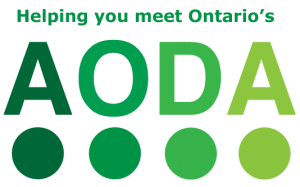A braille embosser is a hardware device for “printing” a hard copy of a text document in braille. A braille translation software program is required to translate the electronic text from the computer into braille. Most braille embossers come with the following features:
- Transcribe print text into embossed braille output
- Speech feedback as you use the embosser
- Embossers vary with printing speed, line width and type and weight of paper used
- Available in single or double sided
It is important to consider the following capabilities: supporting grade 1, 2, UEB, etc. braille, braille page preview; support of formatting tables, mathematics and symbols; languages available; type of files accepted, etc.
Other types of braille software to consider include:
- Braille translation software to turn documents into braille for embossing. Some embossers have built-in translators, but this may or may not be sufficient depending your formatting requirements.
- Braille Music translation software that will convert music notation into braille.
- Optical Braille Recognition Software which allows you to scan a braille document and convert it to printed text. This is useful for people who work with individuals who read braille, but do not read braille themselves.
Questions to consider when choosing a Braille Embosser
Features
- Do you need special characters or layout in braille? E.g., for mathematics, scientific or music notations. Consider the braille translation software chosen, as not all software provides the same features.
- Does it print single-sided or double-sided? Single sided braille embossers are ideal for occasional use; double sided braille embossing reduces the numbers of pages and weight of the finished document. This is ideal for those who carry their work around.
- What is its embossing speed (measured in characters per second, or CPS)? This information will help you decide when looking at the volume of braille you are going to produce and how frequently you will use the embosser.
- Does it allow you to work in both print and braille? Does it support graphics?
- Does it need to also be a braille typewriter (i.e. have a braille keyboard)?
- Is the height of the characters adjustable?
- Is it stationary or portable? Consider the weight of the embosser. Single sided braille embossers are more compact and transportable.
- Consider the environment in which the embosser will be used. Do you need a soundproof case?
- What is its power source? (e.g., Do you need to have a wall outlet available? Is it USB powered?) What is the battery life of the device?
Compatibility
- Is it compatible with your computer or device’s operating system? (i.e. is there the right driver to work)
- Do you have the right connections, adaptors, or wireless support (e.g., Bluetooth, wifi) to connect?
- Does it come with built-in braille translation software and how well does that software work?
- What type of paper can be used for printing? How expensive is the paper?
Usability
- How complex are the physical controls and does the user need to make adjustments to these?
- What is its embossing speed (measured in characters per second, or CPS)? This information will help you decide when looking at the volume of braille you are going to produce and how frequently you will use the embosser.
Support
- What is the warranty available for the technology? How are repairs handled? (e.g., is there someone in your area?)
- How will you get support if you need it? (e.g., a technician in the school, a local vendor, by telephone, by email, remote access, etc.)
Resources
Braille Embosser Manufacturers and Vendors
Links are provided for information purposes only. SNOW does not endorse any of the following software and hardware.
Braille Translation Software Manufacturers
Braille Music Translation Software Manufacturers
Optical Braille Recognition Software
Braille Typewriter Manufacturers
Free or Open Source Braille software
Dots (Linux)
How It Relates to the AODA legislation
Braille Embosser relates to the following sections of the Accessibility for Ontarians with Disabilities Act (AODA) Integrated Accessibility Standards, specifically some of the following sections in the Information and Communication Standards:
- Accessible Feedback Process
- Accessible Formats and Communication Supports
- Producers of Educational Training Material
- Libraries of Educational and Training Institutions
AODA Significance
- A Braille Embosser with the braille translation software are necessary technology required in order to create braille materials — an alternative format to convey and receive information for people with visual disabilities.
- People interact, learn and communicate in diverse ways. Learning opportunities are increased when flexible ways of engaging with learning materials are provided. Considering how people communicate is important for knowledge to be exchanged. Alternative formats take into account diverse ways of exchanging information.
- The AODA legislates that educational institutions and its employees know how to produce accessible or conversion ready versions of textbooks and printed material and be knowledgeable at interacting and communicating with people with disabilities who may use alternate formats and devices.
Additional Resources
To learn how this section relates to the core principles of the AODA Customer Service regulation, visit the AODA page on SNOW.
A Teaching Guide for Introducing Braille to Kids: One is Fun
To learn of ways to innovate, develop, and design for accessibility, visit OCAD University’s Inclusive Design Research Centre (IDRC) website and the IDRC’s floe project website.
Want to learn more about braille and other alternative formats? Visit our section on Alternative Formats!
